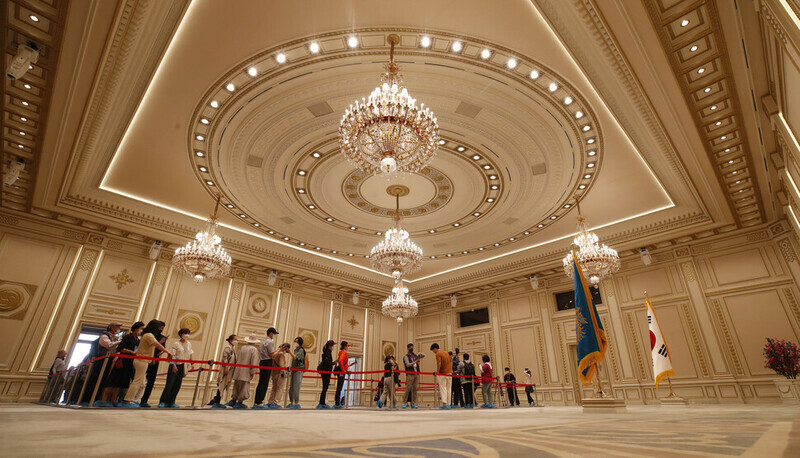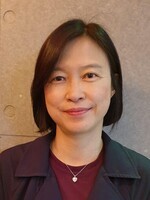hankyoreh
Links to other country sites 다른 나라 사이트 링크
[Column] A palace fit for hagiography


With the inauguration of the new Yoon Suk-yeol administration came a plan to “return” the Blue House back to the Korean public.
The Ministry of Culture, Sports and Tourism (MCST) presented a blueprint for a “living, breathing Blue House” in a report to the president on Thursday.
The blueprint includes plans to transform the main building of the Blue House into a high-class art complex exhibiting both modern and contemporary art as well as spaces where people can experience firsthand the lives, leadership, and power of former presidents. In addition to aiming to preserve its cultural heritage by turning the Blue House into a cultural complex, the Blue House gardens would serve as a sculpture garden and an amphitheater.
In a press briefing on July 20, the MCST repeatedly expressed its intention to do restoration work on the original spaces of the Blue House and to then turn it into Korea’s equivalent of France’s Palace of Versailles, reorganizing the new spaces in such a way to serve as a permanent area for exhibiting artwork.
The ministry also announced its establishment of an advisory board consisting of scholarly experts on Korea’s past presidents and some relatives of former presidents in order to create a space that accurately reflects the history and culture of South Korea's heads of state.
The ministry is planning on consulting the daughter-in-law of former President Syngman Rhee and the sons of former Presidents Yoon Po-sun, Park Chung-hee, Roh Tae-woo, Kim Young-sam, and Kim Dae-jung.
Since the announcement of the report had to be coordinated beforehand with the presidential office, it’s safe to say that the president and the ministry were on the same page regarding this new blueprint for the Blue House.
Looking at this plan for the Blue House, it’s easy to see the impatience of the Yoon administration, which hastily decided to open the Blue House to the public on the day of Yoon’s inauguration, May 10. One can also pick up on the unconscious attempt to make politics personal by making use of anecdotes of Korea’s powerful and those who surrounded them.
First, it’s important to look at the hastiness through which this plan was established.
Although some may respond positively to the idea of returning a space that was previously enjoyed only by a few high-ranking, powerful officials back to the public, the method of execution for this plan was all wrong since it was a battle against time from its very inception.
Sufficient time was not taken to properly deliberate on how to best use the space. Instead, the decision was made to open the doors to the public first, limiting the options for what could be done later.
When it is not clear what kind of vision to choose for a public space with deep historical and political significance, those in power tend to prefer the easy path.
In short, this plan is being packaged as “art for the masses.” For example, take the Palace of Versailles, famous for its Baroque-style splendor and authentic French gardens.
Despite it being located quite far from Paris, people sometimes queue for hours in order to be able to tour the palace, especially in the summer peak season. Looking at this example, the Yoon government seems to have decided this was the perfect model to follow.
With the Yoon administration trying to come up with a plan quickly, they ended up adopting the convenient idea that, if the Blue House was turned into an art exhibit and a luxurious space and attracted many visitors, then it would definitely be a success.
However, Louis XIV's decision to build a grand palace in Versailles, 20 kilometers away from the aristocrats in Paris, was to use this space to establish his absolute monarchy.
Regardless of Yoon’s criticism that the Blue House functioned as the headquarters of an “imperial president,” there’s no denying that the former presidential office and residence was at the front and center of South Korean political history, a history through which South Korea came closer and closer to realizing the system of the democratic republic.
I felt a little taken aback upon hearing about the proposal to turn the Blue House into a Korean-style Versailles, and after much thought, it dawned on me that this was because it seemed to be motivated by the Yoon administration’s tendency to paint even those judgments the previous administration made regarding state affairs and policy as “abuse of power.”
The idea that a committee composed of relatives of former presidents would be advising the process through which the Blue House will be transformed into a space where visitors can look back on past presidents is also hard to agree with. The MCST stated that the advisory committee will help the Blue House tell the story of past presidents who lived there based on committee members’ life experiences, which “will enhance national unity.”
But it’s hard to expect a public narrative from those who had a president as their father or father-in-law. It’s just astounding that anyone in their right mind would think of explaining the legacy of former presidents through their personal family history and relationships. We see enough of that kind of storytelling at former presidents’ places of birth or memorial sites dedicated to them typically located in their hometowns.
The specter of the Yoon administration, which has been embroiled in controversy after another regarding the personal relationship those appointed to key posts have with the president himself, looms.
What will we be witnessing at the Blue House moving forward? Colossal structures and an orderly garden imperial presidents supposedly looked upon with the sense that all the power in the world was theirs? Or narratives of personal relationships former presidents formed as fathers, husbands, and sons?
If the MCST’s plans come to fruition, I suspect visitors to the Blue House grounds will find it difficult to feel the tension between easily abusable power and the public’s yearning for freedom and democracy, nor the social demands and visions for the future that Korea’s most powerful leaders ruminated on.
Simply opening up the Blue House to the public will not equalize all citizens. Simply co-displaying the history of former Presidents Syngman Rhee and Park Geun-hye, who stepped down from the presidency dishonorably, side by side with that of former President Kim Dae-jung, who presented a vision for peace on the Korean Peninsula, will not achieve national unity.
What we desperately need right now is an understanding of the dynamic nature of South Korean history, which went through reconstitution after reconstitution, and an open-minded attitude toward dialogue with those with differing opinions.
Please direct questions or comments to [english@hani.co.kr]

Editorial・opinion
![[Editorial] Intensifying US-China rivalry means Seoul must address uncertainty with Beijing sooner than later [Editorial] Intensifying US-China rivalry means Seoul must address uncertainty with Beijing sooner than later](https://flexible.img.hani.co.kr/flexible/normal/500/300/imgdb/original/2024/0517/8117159322045222.jpg) [Editorial] Intensifying US-China rivalry means Seoul must address uncertainty with Beijing sooner than later
[Editorial] Intensifying US-China rivalry means Seoul must address uncertainty with Beijing sooner than later![[Column] When ‘fairness’ means hate and violence [Column] When ‘fairness’ means hate and violence](https://flexible.img.hani.co.kr/flexible/normal/500/300/imgdb/original/2024/0516/7417158465908824.jpg) [Column] When ‘fairness’ means hate and violence
[Column] When ‘fairness’ means hate and violence- [Editorial] Yoon must stop abusing authority to shield himself from investigation
- [Column] US troop withdrawal from Korea could be the Acheson Line all over
- [Column] How to win back readers who’ve turned to YouTube for news
- [Column] Welcome to the president’s pity party
- [Editorial] Korea must respond firmly to Japan’s attempt to usurp Line
- [Editorial] Transfers of prosecutors investigating Korea’s first lady send chilling message
- [Column] Will Seoul’s ties with Moscow really recover on their own?
- [Column] Samsung’s ‘lost decade’ and Lee Jae-yong’s mismatched chopsticks
Most viewed articles
- 1[Editorial] Transfers of prosecutors investigating Korea’s first lady send chilling message
- 2[Exclusive] Unearthed memo suggests Gwangju Uprising missing may have been cremated
- 3[Column] US troop withdrawal from Korea could be the Acheson Line all over
- 4Xi, Putin ‘oppose acts of military intimidation’ against N. Korea by US in joint statement
- 5[Column] When ‘fairness’ means hate and violence
- 6‘Shot, stabbed, piled on a truck’: Mystery of missing dead at Gwangju Prison
- 7[Editorial] Intensifying US-China rivalry means Seoul must address uncertainty with Beijing sooner t
- 8Spotlight turns to Hyundai Group Chairwoman’s visit to North Korea
- 9[Column] Samsung’s ‘lost decade’ and Lee Jae-yong’s mismatched chopsticks
- 10[Column] Will Seoul’s ties with Moscow really recover on their own?